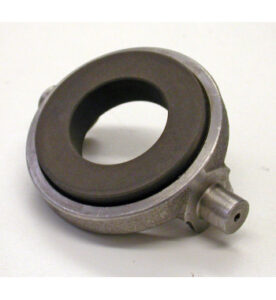
Clutch Bearing
Today’s blog post concerns the type of clutch release bearing fitted to most post war British cars earlier than the 1970’s and a few made even as late as 1980. If you own anything from a Morris Minor to a MK2 Jaguar then you have the type of clutch release bearing under discussion here: The carbon bearing which looks like this image on the left.
The part in the image which looks like a black circle is made of carbon and whenever you put your foot on the clutch pedal it is pressed into the clutch cover in order to compress it and release the clutch. It relies on the frictional co-efficient of the carbon to work, and in the days when traffic was much lighter than today, it worked very well indeed. The problem with the design is that it just wasn’t designed for the sort of traffic density which we see today and if a car is driven regularly in extreme conditions this type of bearing will wear out prematurely.
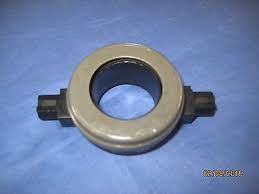
Roller Release Conversion
Some older cars and most more modern cars (ie; those built since the 1980s) nearly always use a roller bearing clutch release assembly or a ball bearing assembly and these stand up to heavy traffic conditions very well indeed.
These days it is possible to purchase an easy conversion to a roller or ball bearing release and it looks something like this:
It doesn’t look unlike the first image of an original carbon release bearing and it is intended as a direct replacement for it. The roller release conversion however doesn’t use carbon as the bearing surface, instead it has an internal roller bearing and a metal face which contacts the clutch pressure plate.
In essence there should be nothing at all wrong with this, after all, many cars used such a bearing from new and worked very well – a good example of this is the Triumph TR6 which uses this type of bearing as standard. The problem is that cars designed to use carbon release bearings do not make any attempt to keep the release bearing concentric with the rotating clutch: This simply does not matter with a carbon release bearing which is designed to utilise the frictional co-efficient of carbon to work in the first place. On these types of cars the carbon bearing is located in the clutch fork which pivots on a bracket inside the bell housing of the gearbox. This pivoting action causes the bearing to describe an arc as it operates so that at most times it is not located concentrically to the clutch assembly.
The problem with replacing the carbon clutch bearing with a roller bearing is that the metal facing of the roller bearing is simply not designed to operate in the way. It will work at first but in many cases it will fail sooner than the carbon item which it has replaced. When it does fail it often takes out the clutch cover plate at the same time which is not good news! Sorry to say it, but after market roller clutch conversions simply do not work!
This phenomenon has already been perfectly described in a YouTube video by University Motors:
https://www.youtube.com/watch?v=4KIdkOWVcGg
For most of us the answer is cheap and simple: Drive your classic car in an appropriate fashion and don’t worry about it!
I have found however that cars driven regularly in London simply don’t fare well with carbon clutch bearings: They tend to require the engine and / or gearbox to be removed about every two years in order to have the release bearing replaced. If you haven’t driven in London recently you may not appreciate quite why…. suffice to say that if the clutch isn’t biting as the traffic lights go amber then the guy behind you is going to start leaning on the horn button!
This calls for a an unobtrusive modification to bring things up to the required standard!
The answer is to employ the design features which manufacturers use as standard when they specify roller or ball release bearings: Stop relying on the clutch fork to locate the release bearing and instead provide a guide tube which is concentric with the gearbox first motion shaft. This modification also involves modifying the clutch fork so that it is no longer responsible for locating the release bearing and the details involved are by necessity different for every individual gearbox.
 The project vehicle for this blog post is a BMC Riley 1.5 which proved to be one of the trickiest conversions due to lack of space. Here’s a photo of the carbon clutch bearing removed from the Riley after just 2 years of driving in the city of London…. as you can see, not only has the carbon completely disappeared but even the cast iron carrier has become worn away after contact with the clutch cover plate. Clearly not an acceptable state of affairs!
The project vehicle for this blog post is a BMC Riley 1.5 which proved to be one of the trickiest conversions due to lack of space. Here’s a photo of the carbon clutch bearing removed from the Riley after just 2 years of driving in the city of London…. as you can see, not only has the carbon completely disappeared but even the cast iron carrier has become worn away after contact with the clutch cover plate. Clearly not an acceptable state of affairs!
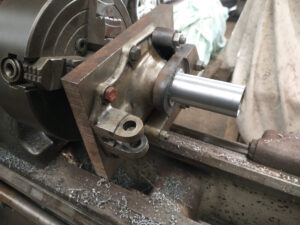 The answer is to produce a guide tube which is concentric to the first motion shaft of the gearbox. This is exactly what manufacturers like Triumph did when they specified a roller clutch release bearing. In the case of the Riley, it was necessary to manufacture a steel bracket to locate the guide tube which bolts onto the bearing housing for the gearbox first motion shaft. In order to keep it perfectly concentric this has to be machined on a specially manufactured fixture on a lathe and it is seen here with the front bearing cover from the BMC gearbox.
The answer is to produce a guide tube which is concentric to the first motion shaft of the gearbox. This is exactly what manufacturers like Triumph did when they specified a roller clutch release bearing. In the case of the Riley, it was necessary to manufacture a steel bracket to locate the guide tube which bolts onto the bearing housing for the gearbox first motion shaft. In order to keep it perfectly concentric this has to be machined on a specially manufactured fixture on a lathe and it is seen here with the front bearing cover from the BMC gearbox.
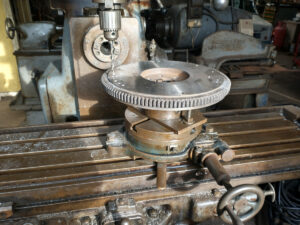 In this case the flywheel was reduced in thickness and then surface ground before re drilling and re dowelling to take a more modern diaphragm cluch.
In this case the flywheel was reduced in thickness and then surface ground before re drilling and re dowelling to take a more modern diaphragm cluch.
The Riley gearbox bellhousing is quite tight on available spaces so it was also necessary to machine this in order to provide clearance for the new diaphragm clutch cover to replace the orginal coil sprung clutch cover.
In addition to this work is was also necessary to manufacture a phosphor bronze carrier for the new clutch release and to modify the clutch fork in order to engage with the new carrier. The end result looks like this when assembled into the gearbox bell housing.
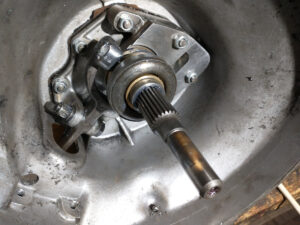 .The clutch release bearing is now mounted on a purpose built phosphor bronze carrier and is maintained in a concentric position relative to the first motion shaft by the steel bracket and guide tube bolted over the bearing housing.
.The clutch release bearing is now mounted on a purpose built phosphor bronze carrier and is maintained in a concentric position relative to the first motion shaft by the steel bracket and guide tube bolted over the bearing housing.
The clutch bearing is from a Jaguar XJ6 Series 3 and is a deliberate piece of “over engineering” to cope with heavy London traffic!
The end result is a perfectly concentric roller clutch release bearing which gives “modern car style mileages” in heavy city traffic. This one was installed 3 years ago and is still fault free:
If your classic car has a carbon clutch release and you regularly drive it in the sort of traffic density which is to be found in London then in my experience this sort of discrete conversion can be very well worthwhile. If you don’t regularly drive in this sort of traffic then simply getting into the habit of selecting neutral at traffic lights will be all that is needed to ensure long service from your clutch bearing.

May I begin by saying how utterly delightful it is to be reading your blog posts once again!
I have two questions that I wish ask – the first being personal in nature and the second is very much directly related to the content of your blog.
1. I am looking forward to the restoration (and hotting up) of my own MK2 by yourself and wonder what are your considerations for the carbon bearing on the car.
While the plan is have a reliable car for driving tours in areas such as the Alps, might I have a case for a ‘subtle modification’ should I wish to explore the bustling metropolis of any country in which I tour in order to explore its culture, shops and hidden treasures?
2. The modification which you carried out involved reducing the thickness of the flywheel.
Did this have an effect on the performance of the car?
Thank you for your words of encouragement! These are particularly relevant questions which add very useful dimensions to the original post.
Firstly, in terms of my considerations for a release bearing conversion for your MK2 Jaguar I must confess that this is something for which I am still weighing up the pros and cons. As you know, the gearbox and overdrive have already been rebuilt and now progress on the engine is well under way. As things stand the gearbox bell housing is still set up to use the original carbon release bearing.
The biggest factor in my mind against any modification concerns the current availability of clutch components: Not so long ago it was possible to purchase high quality after market clutch cover plates in any number of different specifications however the company which used to supply these is no longer able to do so. Because of this it would seem that the only reliable, high quality clutch cover available to fit as part of a high quality roller release conversion is the one for the 4.2 Litre Jaguar XJ6 Series 3 – a car which was very rare to find with manual transmission and for which the clutch covers are becoming even more rare. Even if a clutch cover can be obtained now, replacing it when it is worn out may become more of a problem. The original clutch cover for the MK2 will not work well with a roller release conversion.
The next factor concerns the fitting in your particular car: Since your body shell was made for an automatic transmission, the gearbox tunnel is a little wider than those in the original manual gearbox cars. This extra width makes it possible to remove a manual gearbox (when fitted) without the large amount of work required on standard MK2 cars where it is necessary to remove both engine and gearbox together. Because of this, replacing the carbon clutch bearing when needed becomes a much quicker job which might take an afternoon as opposed to the 2 days needed on a standard car.
In fact the only drawback to this situation with the larger gearbox tunnel is that there will be a little less room around the clutch pedal compared to a factory – standard car. This is not usually a problem and should the local car thieves in the bustling metropolis have bulky “size twelves” to match their wide necks then it will prove harder for them to make off with the car in a hurry.
Secondly in answer to your question about reducing the thickness of the flywheel: This is something which can potentially alter the way that the car drives although it will have no effect on engine power output. In the case of the conversion to the Riley in this post, the amount removed from the flywheel was too small to have any noticeable difference.
The flywheel uses momentum to keep the engine turning between the firing pulses of the cylinders. A four cylinder, four stroke engine outputs power a bit like bicycle pedals do: One power stroke every half turn (180 degrees) and if it were not for the flywheel it would stall between power strokes. Six cylinder engines like your Jaguar have one power stroke every 120 degrees and can have slightly lighter flywheels to achieve the same thing as the ones on their four cylinder counterparts.
Just as flywheels have momentum, they also have inertia so that when you “put your foot down” to speed the car up, the engine not only has to provide power to accelerate the car but it also has to provide power to overcome the inertia of the flywheel. Lightening the flywheel can make the car accelerate more quickly by removing some of this power requirement from the engine, however it can also make the car require more skill to drive it because it will be more easy to stall.
The Jaguar MK2 had quite a heavy flywheel to make it easier to drive and in a way which feels like a luxury car in traffic. I believe that it was the fastest production four door saloon available for the whole of the 1960s so presumably Jaguar felt that in this department they could easily afford to tilt the compromise a little towards comfort and driveability without getting any complaints.
The Jaguar E Type as another example used a rather lighter flywheel and is still very easy to drive….. the flywheel which Is going on to your engine is very light indeed. It is purported to be an Jaguar ex – works lightened flywheel and it certainly looks like one; I’ve driven a 3.8 litre MK2 fitted with this very item and it was very lively indeed and required only a small learning curve to get used to it in traffic!